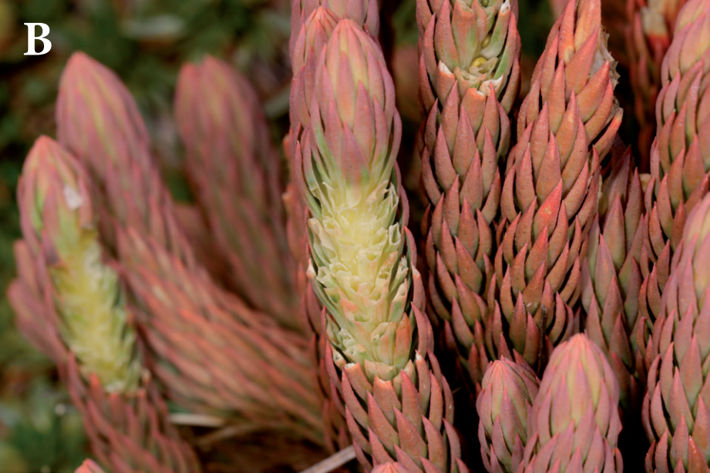Unusual feeding record for a Neotropical rodent: a common Andean lycophyte
DOI:
https://doi.org/10.31687/saremNMS.20.0.40Resumen
El ratón orejón de Haggard, Phyllotis haggardi, es un roedor endémico de Ecuador que carece de estudios detallados sobre su ecología. En esta nota reportamos por primera vez que la dieta de P. haggardi incluye esporas de Phlegmariurus crassus, una licofita común de los páramos andinos. Este es un registro importante, ya que el consumo de esporas de licofitas por parte de mamíferos es raro, detallándose además un nuevo comportamiento para P. haggardi. Con este hallazgo contribuimos con la historia natural de esta especie de roedor y destacamos la presencia de licofitas como un potencial recurso alimenticio para los pequeños mamíferos que habitan los ecosistemas andinos.
Citas
Arana, M. D., H. Reinoso, & A. J. Oggero. 2014. Morphology and anatomy of caulinar axes, lycophylls and sporangia of Phlegmariurus phylicifolius: a contribution to the systematics of Neotropical Lycopodiaceae. Revista de Biología Tropical 62:1217–1227.
Armijos, C., et al. 2016. Phytochemical and ethnomedicinal study of Huperzia species used in the traditional medicine of Saraguros in Southern Ecuador; AChE and MAO inhibitory activity. Journal of Ethnopharmacology 193:546–554.
Arosa, M. L., J. A. Ramos, L. G. Quintanilla, & D. Brown. 2010. First report of fern (Culcita macrocarpa) spore consumption by a small mammal (Apodemus sylvaticus). Mammalian Biology 75:115–121.
Arregoitia, L. D. V. 2016. Rethinking omnivory in rodents. Preprint. https://doi. org/10.20944/preprints201609 17:v1.
Barbé, M., et al. 2016. Dispersal of bryophytes and ferns is facilitated by small mammals in the boreal forest. Écoscience 23:67–76.
Boonstra, R., & I. T. M. Craine. 1986. Natal nest location and small mammal tracking with a spool and line technique. Canadian Journal of Zoology 64:1034–1036.
Cox, P. G., E. J. Rayfield, M. J. Fagan, A. Herrel, T. C. Pataky, & N. Jeffery. 2012. Functional evolution of the feeding system in rodents. PLoS ONE 7:e36299.
Daniel, M. J. 1976. Feeding by the short-tailed bat (Mystacina tuberculata) on fruit and possibly nectar. New Zealand Journal of Zoology 3:391–398.
Erdtman, G. 1960. The acetolysis method—a revised description. Svensk Botanisk Tidskrift 54:561–564.
Kearns, C. A., & D. W. Inouye. 1993. Techniques for pollination biologists. University press of Colorado.
Konrath, E. L., M. G. Ortega, S. de Loreto Bordignon, M. A. Apel, A. T. Henriques, & J. L. Cabrera. 2013. Alkaloid profiling and anticholinesterase activity of South American Lycopodiaceae species. Journal of Enzyme Inhibition and Medicinal Chemistry 28:218–222.
Ma, X., & D. R. Gang. 2004. The Lycopodium alkaloids. Natural Product Reports 21:752–772.
Miles, M. A., A. A. De Souza, & M. M. Póvoa. 1981. Mammal tracking and nest location in Brazilian forest with an improved spool-and-line device. Journal of Zoology 195:331–347.
Naylor, L., & N. Roach. 2016. Phyllotis haggardi (errata version published in 2017). The IUCN Red List of Threatened Species, 2016:e.T17227A115140273.
Øllgaard, B. 1990. Pteridophytes and Gymnosperms. The Families and Genera of Vascular Plants, Vol. 1. (K. U. Kramer & P. S. Green, eds.). Springer, Berlin.
Pardiñas, U. F. J., et al. 2017. Cricetidae (true hamsters, voles, lemmings and new world rats and mice) – Species accounts of Cricetidae. Handbook of the Mammals of the World – Volume 7: Rodents II (D. E. Wilson, T. E. Lacher, & R. A. Mittermeier, eds.). Lynx Edicions, Barcelona.
Rincón, E. J., H. C. Rolleri, F. Alzate Guarin, & J. M. Dorado Gálvez. 2014. Ontogeny of the sporangium, spore formation and cytochemistry in Colombian Lycopodials (Lycopodiaceae). Revista de Biología Tropical 62:282–307.
Steppan, S. J., & O. Ramírez. 2015. Genus Phyllotis Waterhouse, 1837. Mammals of South America. Volume 2: Rodents (J. L. Patton, U. F. J. Pardiñas, & G. D'Elía, eds.). The University of Chicago Press, Chicago and London.
Tirira, D. 2017. A Field Guide to the Mammals of Ecuador. Murciélago Blanco Publishing House, Quito.

Descargas
Publicado
Cómo citar
Número
Sección
Licencia
Derechos de autor 2020 Ricardo Zambrano-Cevallos, Ariatna Villarreal, Susana León Yánez, Benjamin Øllgaard

Esta obra está bajo una licencia internacional Creative Commons Atribución-NoComercial 4.0.

